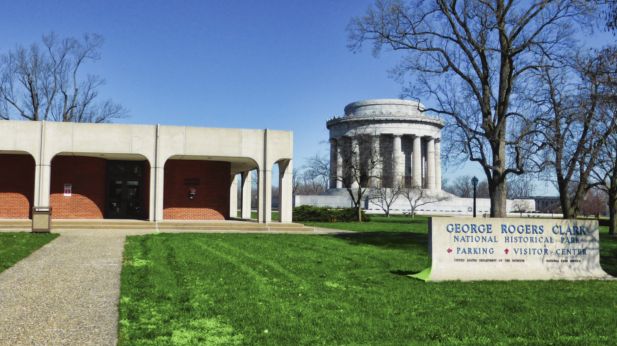
Follow George Rogers Clark and Red Skelton to Vincennes
TRAVEL | Mary Bohlen
Red Skelton and George Rogers Clark are far apart on the spectrum of American history, but the paths of the comedy icon and the Revolutionary War hero meet in Vincennes, Indiana. You should beat a path there too.
Vincennes, a Wabash River town 163 miles from Springfield, is Skelton’s hometown, and his legacy reverberates in the Red Skelton Museum of American Comedy with his character costumes, props and paintings. The imposing monument to Clark is the largest on any U.S. battlefield and part of a national historical park.
If you head to Vincennes on May 23-24, you also can help the town celebrate its French history at the 39 th annual rendezvous with battlefield re-creations, games, frontier skills, period music, an encampment of Northwest Territory Alliance soldiers, old-time food and a variety of entertainment.
Frank Doughman, superintendent of the George Rogers Clark National Historical Park, said the annual Memorial Day weekend rendezvous draws up to 25,000 visitors. “It’s kind of an iconic event for the park and the city,” he said. “In the living history realm, this is a big one, especially for the Revolutionary War.”
If you are visiting Vincennes during the week, pick up a map and brochures at the town’s visitors’ center, which is open from 8 to 4 Eastern time Monday through Friday. With a population of 18,000, however, Vincennes is small enough that you can find all the highlights on your own or take a cellphone tour if you visit weekends or evenings.
The interactive Skelton museum is one of those highlights. Adults old enough to remember such characters as Clem Kadiddlehopper and Freddie the Freeloader can view Skelton’s full costumes, makeup case and props. Visitors too young to have seen his last show in 1971 will learn about Skelton in a 10-minute film, as well as radio and television clips and his Emmy statues.
Children of all ages will enjoy making sound effects, designing clown faces and pantomiming in front of a green screen. The museum draws tour groups, schoolchildren and a lot of senior citizens, according to Jerri Johanningsmeier, the museum store manager.
Grandparents like to introduce their families to Skelton, she said. “They may not know him but once they come, they love him.”
Located on the Vincennes University campus and open Tuesday-Saturday from 10-5 and Sunday noon-5, the museum unveiled its full displays last July. Skelton’s third wife donated many of the artifacts, and the museum has 300 of his paintings, hanging them on a rotating basis. The comic, who died in 1997, liked to paint clowns.
Near the campus are Grouseland, former home to U.S. President William Henry Harrison, and the Vincennes State Historic Site, a collection of preserved buildings from early Indiana history. Included in the paid attractions are the original Capitol, a print shop and the Jefferson Academy, the state’s first higher education institution.
Of greater significance to most tourists is the free national historical park dedicated to Clark along the Wabash shore. At the visitors’ center, which is open daily 9 to 5 except major holidays, you can watch a film to refresh your memory of Clark’s exploits in the West during the American Revolution. You also can clear up a common confusion that George went exploring with Meriwether Lewis. That was his younger brother, William.
The columned granite, limestone and marble memorial sits on the site of a former British fort, which George
and his small army of frontiersmen and French volunteers captured with
surprising ease after a bitter winter trek from Kaskaskia, Illinois.
Seven large murals under a massive dome tell his story of helping make
sure those of us living west of the Appalachian Mountains are not
singing “God Save the Queen” or speaking French.
After
visiting the park, stroll over to the Old Cathedral Basilica of St.
Francis Xavier, Indiana’s oldest congregation. The 1826 building has
roots in the 1700s, when the French established a fort and fur-trading
settlement. The church’s stained glass windows are undergoing
restoration, and several murals from the 1800s add to the interior
luster.
Military
artifacts buffs may want to take in the Indiana Military Museum to view
aircraft, artillery, uniforms and vehicles from the Civil Way to present
day. “The curator started collecting when he was 8 years old,” said
Loretta Day of the Vincennes Visitors and Tourism Bureau next door, and a
hobby turned into one of the largest collections in the Midwest.
Tours
of the Old French House, built around 1809, are available by
appointment as are visits to the Old Cathedral Library. The library
houses 10,000 volumes, some dating back to 1319.
You
can participate in a self-guided architecture tour of buildings
representing many different styles or visit downtown art galleries on
the First Friday Art Walk, held each month.
These
21 st century initiatives surely would have been far from the
imaginations of 18 th century Clark or 20 th century Skelton when their
paths led them to Vincennes.
For more information, visit www.visitvincennes.org, www.nps.gov/gero, www.redskeltonmuseum.org
and www. inmilitarymuseum.com. Call 812-882-7422 for Old French House
tours and 812-882- 5638 for visits to the Old Cathedral Library.
Vincennes is in the Eastern time zone, and all hours listed above
reflect that.
Mary
Bohlen is a freelance writer and editor from Springfield and former
chair of the Communication Department at the University of Illinois
Springfield. She alternates writing the monthly Midwestern travel column
for IT with Mary C. Galligan of Chicago.
